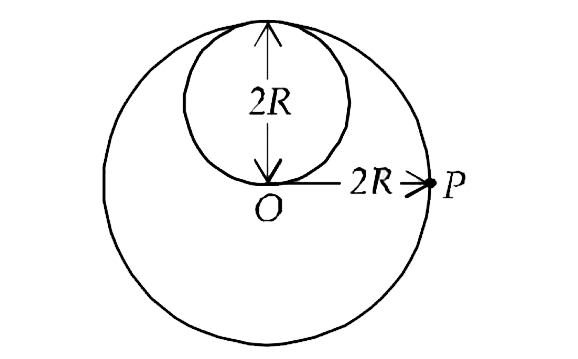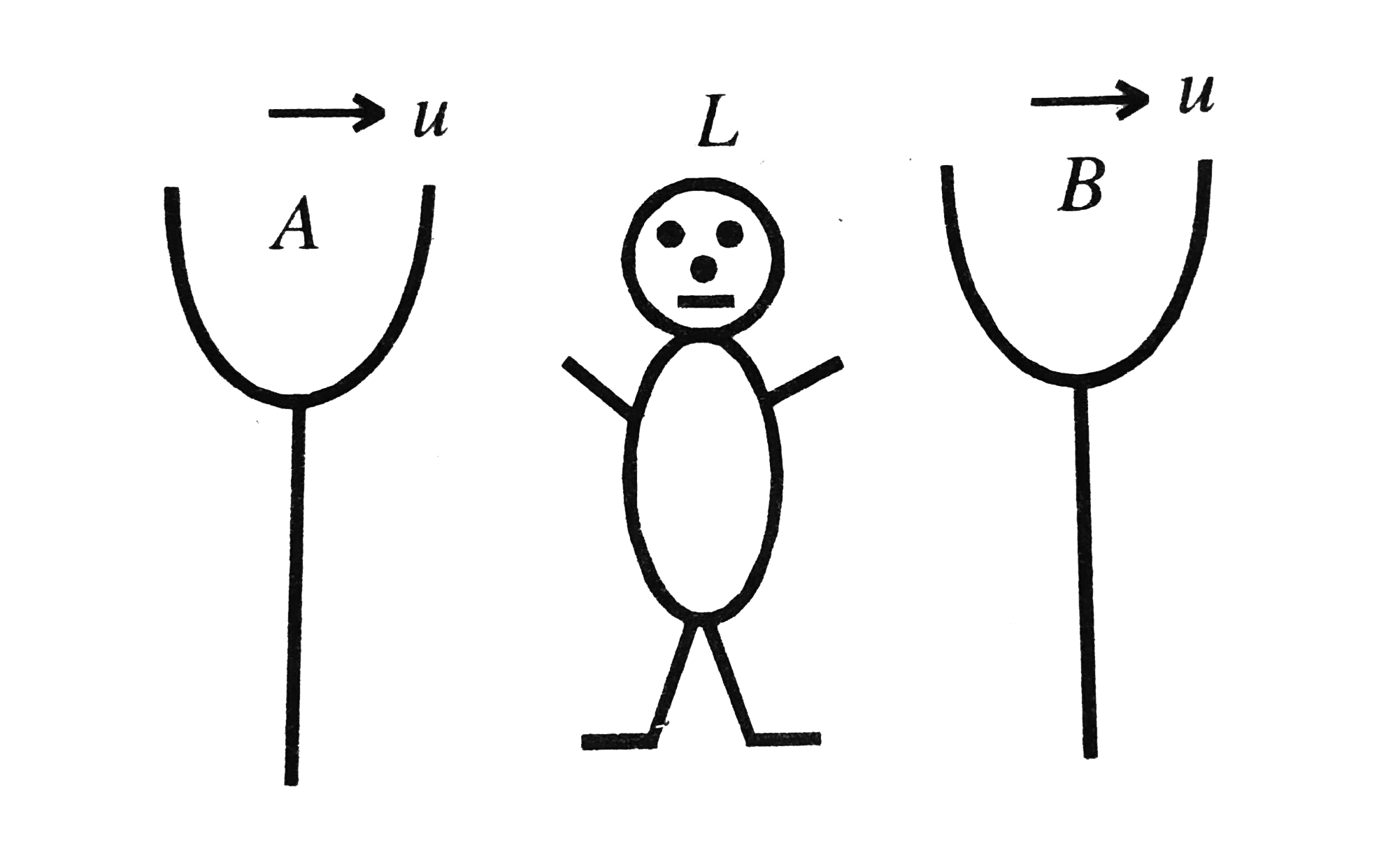A vibrating tuning fork tied to the end of a string 1.988 m long is whirled round a circle. If it makes two revolutions in a second, calculate the ratio of the frequencies of the highest and the lowest notes heard by an observer situated in the plane of the tuning fork. Valocity of sound is 350 m/s.
The number of revolutions per second is 2. Radius of the circle is 1.988m.
The linear velocity of the tuning fork is
v=2×2πr=4×227×1.988=25ms
i. Apparent frequency when the tuning fork is approaching the listener is
n1=vnv−vs=350n350−25=1413n
ii. Apparent frequency when the tuning fork is moving away from the listener is
n2=vnv+vs=350N(350−25)=1415n
The ratio of highest note to the lowest note is given by
n1n2=14n13×1514n=1513=1.154
Topper's Solved these Questions
- SOUND WAVES AND DOPPLER EFFECTBook:CENGAGE PHYSICSChapter:SOUND WAVES AND DOPPLER EFFECTExercise:Single Correct
Explore 252 Videos
- SOUND WAVES AND DOPPLER EFFECTBook:CENGAGE PHYSICSChapter:SOUND WAVES AND DOPPLER EFFECTExercise:Multiple Correct
Explore 44 Videos
- SOUND WAVES AND DOPPLER EFFECTBook:CENGAGE PHYSICSChapter:SOUND WAVES AND DOPPLER EFFECTExercise:Exercise 6.2
Explore 72 Videos
- RIGID BODY DYNAMICS 2Book:CENGAGE PHYSICSChapter:RIGID BODY DYNAMICS 2Exercise:Interger
Explore 2 Videos
- SUPERPOSITION AND STANDING WAVESBook:CENGAGE PHYSICSChapter:SUPERPOSITION AND STANDING WAVESExercise:Comprehension Type
Explore 5 Videos
Similar Questions
A man is watching two trains, one leaving and the other coming in with equal speed of 4m/s. If they sound their whistles, each of frequency 240 Hz, the number of beats heard by the man (velocity of sound in air is 320m/s will be equal to
View SolutionWhich of the following statements are incorrect?
View SolutionA person riding on a merry go round emits a sound wave of a certain frequency Does a person at the centre observe the Doppler effect?
View SolutionA lamina is made by removing a small disc of diameter 2R from a bigger disc of uniform mass density and radius 2R, as shown in the figure. The moment of inertia of this lamina about axes passing though O and P is IOandIP respectively. Both these axes are perpendicular to the plane of the lamina. The ratio IPIO ot the nearest integer is

View SolutionA string of length L, fixed at its both ends is vibrating in its 1st overtone mode. Consider two elements of the string of the same small length at positions l1=0.2Landl2=0.45L from one end.
If K1andK2 are their respective maximum kinetic energies,then
View SolutionTwo tuning forks A and B are vibrating at the same frequency 256 Hz. A listener is standing midway between the forks. If both tuning forks move to the right with a velocity of 5(m)/(s) , find the number of beats heard per second by the listerner (speed of sound in air is 330(m)/(s) ).
View SolutionA vibrating tuning fork tied to the end of a string 1.988 m long is whirled round a circle. If it makes two revolutions in a second, calculate the ratio of the frequencies of the highest and the lowest notes heard by an observer situated in the plane of the tuning fork. Valocity of sound is 350 m/s.
View SolutionWhen a tuning fork of frequency 341 is sounded with another tuning fork, six beats per second are heard. When the second tuning fork is loaded with wax and sounded with the first fork, the number of beats is two per second. The natural frequency of the second tuning fork is
View SolutionA tuning fork sounded together with a tuning fork of frequency 256 emits two beats. On loading the tuning fork of frequency 256, the number of beats heard are 1 per second. The frequency of tuning fork is
View SolutionThe frequency of a tuning fork is 220 Hz and the velocity of sound in air is 330 m/s. When the tuning fork completes 80 vibrations, the distance travelled by the wave is
View SolutionA 50 cm long pipe, open at both ends, produces resonant vibration with a tuning fork. If the velocity of sound in air is 350 m*s^(-1) , what is the frequency of the tuning fork ?
View SolutionA tuning fork of frequency 90 is sounded and moved towards an observer with a velocity of sound, the note heard by the observer
View SolutionTwo tuning forks give 4 beats/s when sounded together. First tuning fork resounds with a closed air column 20 cm long and second tuning fork resounds with an open air column 40.5 cm long. Determine the individual frequencies of the two tuning forks neglecting end correction.
View SolutionA tuning fork has frequency 512 Hz. The number of vibrations of the fork in the time during which the sound from the tuning fork reaches 332 m in air are (velocity of sound in air is 332 m//s .)
View Solution Two tuning forks A and B are vibrating at the same frequency 256 Hz. A listener is standing midway between the forks. If both tuning forks move to the right with a velocity of 5ms, find the number of beats heard per second by the listerner (speed of sound in air is 330ms).
Two tuning forks A and B are vibrating at the same frequency 256 Hz. A listener is standing midway between the forks. If both tuning forks move to the right with a velocity of 5ms, find the number of beats heard per second by the listerner (speed of sound in air is 330ms).
View SolutionA vibrating tuning fork tied to the end of a string 1.988 m long is whirled round a circle. If it makes two revolutions in a second, calculate the ratio of the frequencies of the highest and the lowest notes heard by an observer situated in the plane of the tuning fork. Valocity of sound is 350 m/s.
View Solution
